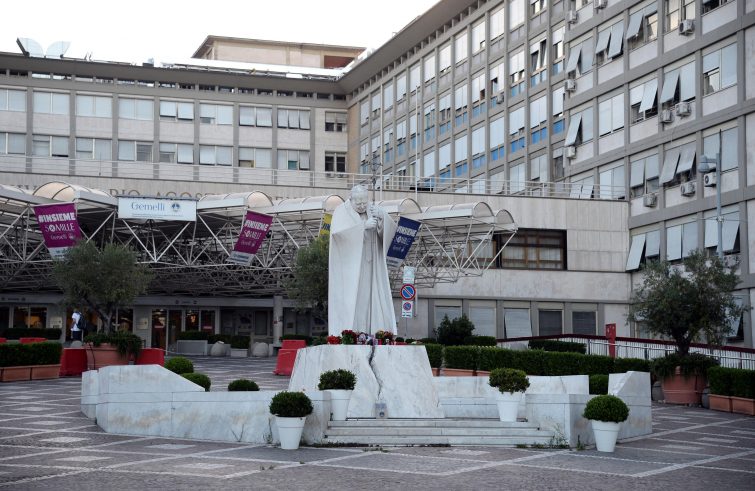
“The post-operative process is regular. Routine follow-up examinations are good”, reads the third medical bulletin released after the Pope underwent surgery. On the second day at the Gemelli Hospital the Holy Father “had a good night’s rest”, “this morning he had breakfast, read some newspapers and got up to walk”, made known the Director of the Holy See press office Matteo Bruni in a statement. Bergoglio’s first hospital admission in eight years of pontificate was unexpected news to journalists on a day – July 4 – that had started as always with the Sunday Angelus, during which the Holy Father announced to the faithful his forthcoming visit to Budapest and Slovakia in September, and continued with an official communiqué from the Holy See Press Office in which its director announced that Francis was admitted to Rome’s Gemelli Polyclinic to undergo planned surgery for a symptomatic diverticular stenosis of the colon. The long-awaited first medical bulletin was released shortly before midnight: “The Holy Father reacted well to the operation” performed by Prof. Sergio Alfieri, Bruni reported with regard to the surgery for diverticular stenosis of the sigma, conducted under general anaesthesia in the evening. In addition to Prof. Alfieri, his assistants, the anaesthetist and the Pope’s personal physician, Prof. Roberto Bernabei, were present in the operating theatre. The second medical bulletin from Gemelli Hospital concerning the illustrious patient admitted on the tenth floor, in the same rooms which St. John Paul II had jokingly termed the “third Vatican” owing to his frequent hospital stays, was issued at midday on July 5th. “His Holiness Pope Francis is in good general condition, alert and breathing spontaneously”, said the Vatican spokesman, detailing that “the surgery for diverticular stenosis carried out in the evening of 4 July involved a left hemicolectomy and lasted around three hours. The Holy Father is expected to remain in hospital for approximately seven days, barring any complications.”
Outpouring of good wishes. Naturally, the announcement of the Pope’s hospitalization immediately hit world news, drawing the concerned attention not only of insiders, but also of the faithful and ordinary people, such as the many people admitted to or visited in Rome’s hospital. Just to mention the Italian context, on 5 July, Pope Francis received best wishes for a speedy recovery – among many others – from the President of the Italian Bishops’ Conference, the Head of State and the Prime Minister. “Even on this occasion his example shows us how to deal with suffering”, wrote Cardinal Bassetti: “The gaze directed towards the commitments of the coming months (the trip to Hungary and Slovakia in September) and his characteristic smile from the window of the Apostolic Palace, with which he meets us every Sunday, are a powerful testimony. Never surrender to discouragement even in the hours of greatest toil. Thank you, Holy Father!” The Cardinal expressed “the closeness of our Churches, our communities, our faithful, with best wishes for a smooth and speedy recovery.” His Eminence entrusted to the Lord “the doctors and all the health care workers who are taking care of you and of all patients with passion and love.” “Your Holiness, after landing in Paris for the State visit that I am about to begin in neighbouring and friendly France, I learned of your hospitalisation at the Gemelli Hospital”, reads President Mattarella’s telegram: “The heartfelt thoughts of all Italians, which I convey to you with my own, accompany Your Holiness at this time, together with the most cordial wishes for a smooth and speedy recovery.” Prime Minister Draghi also expressed affectionate wishes for a speedy recovery to the Holy Father in a statement issued by Palazzo Chigi. One of the most welcomed wishes was certainly the one coming from Benedict XVI, through his personal secretary, Monsignor Georg Ganswein.
The same window. This is the first time that 84-year-old Jorge Mario Bergoglio has been admitted to hospital since his elevation to the papacy, and the second major surgery performed under general anaesthesia in his life, after surgery on his right lung in Buenos Aires at the age of 21. Based on the expected time of hospitalisation, Pope Francis is likely to deliver the next Angelus prayer from his room on the tenth floor, overlooking the hospital’s main courtyard. That is where St John Paul II also appeared several times to recite the Marian prayer as a “simple” patient, but addressing the whole world. The two popes are not lacking in discretion and positive mood. In fact, Francis arrived at the capital’s hospital with no fanfare, like any other patient, carrying only his personal belongings. After the operation, he is said to have joked with the doctors and nurses at his bedside, as well as with the Vatican security guards watching over him.










